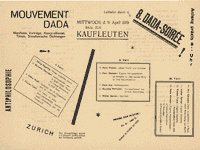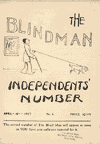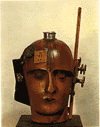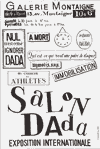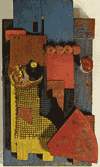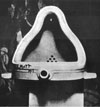The Dada movementMarcel Duchamp
|
The Dada Movement |
Dada: artists' response to WWI
A short video from the Cabaret Voltaire presenting Dada.
Zurich was the birthplace of the Dada movement and its opposition to the cultural values its artists believed had led to the First World War. It all began at the city's Cabaret Voltaire in February 1916.
Switzerland was a neutral country during the First World War and many European artists sought refuge here, including the German founder of Cabaret Voltaire, Hugo Ball.
The Dadaists published books and created paintings and sculptures, but the real spirit of Dada was in events: cabaret performances, demonstrations, declarations, confrontations, the distributions of leaflets and of small magazines and newspapers and actions which today we would call guerrilla theatre.
When Hans Arp and Richard Huelsenbeck joined the group, they started making collages and wooden sculptures. The Cabaret Voltaire artists did not restrict themselves to being painters, writers, dancers or musicians; most of them were involved in several art forms and in breaking down the boundaries which kept the arts distinct from one another.
The Cabaret Voltaire building has been lovingly restored, and turned into a museum. It's a lasting memorial to the dadaists, whose activities had such a huge influence on the development of 20th century art.
Dada - The non-art movement 1916-1923
A very useful presentation of Dada for classroom use by teachers.
Art Movements for the Non-Arts Student: Dada
"What this means is that they were generally in opposition to everything art stood for. They ignored aesthetics. They affronted sensibilities. In all, their thoughts concerning traditional culture were also thoughts of destruction."
A short illustrated introduction to Dada from The Varsity, the independent student newspaper for the University of Cambridge.
The Dada art movement
A good overview by Tome Wilson in DIESELPUNKS.
Dada: The irreverent, rowdy revolution set the trajectory of 20th-century art
Illustrated article by Paul Trachtman in the Smithsonian Magazine, May 2006.
The Basics of Dada Movement in Art
Dada was an artistic and literary movement that started in Europe when World War I was going on. Because of the war, many artists, intellectuals and writers, especially those from France and Germany, moved to Switzerland, which was a neutral country. Instead of being relieved that they had escaped, the artists, intellectuals and writers were furious with the modern society. So, they decided to show their protest through artistic medium. They decided to create non-art since art in the society anyway had no meaning.
The so-called non-artists turned to creating art that had soft obscenities, scattered humor, visible puns and everyday objects. The most outrageous painting was created by Marcel Duchamp, when he painted a mustache on a copy of Mona Lisa and scribbled obscenities under it. He also created his sculpture called Fountain, which was actually a urinal without the plumbing and it had a fake signature.
The public were repulsed by the Dada movement. However, the Dadaists found this attitude encouraging. And, slowly the movement spread from Zurich to other parts of Europe and New York City. Just as many mainstream artists were thinking about this movement seriously, the Dada movement dissolved around the early 1920s.
This art movement was a protest, but at the same time it managed to be enjoyable and amusing. It was sarcastic, colorful, quirky and silly. If a person at that time had not been aware of the logic behind the movement, he or she would have been wondering what the artist was up to creating pieces like the ones that were created. However, the artist who created the Dada art was very serious about his work. The movement did not favor one medium over another. It used everything from glass to plaster to geometric tapestries to wooden reliefs. In addition, the movement was also responsible for influencing many trends in the field of visual art, the most well-known being Surrealism.
About the author:
Pauline Go is an online leading expert in the education industry.
A Frothy Nothing - What is Dadaism
"In those days we were all Dadaists. If the word meant anything at all, it meant seething discontent, dissatisfaction and cynicism. Defeat and political ferment always give rise to that sort of movement.
We held Dadaist meetings, charged a few marks admission and did nothing but tell people the truth, that is, abuse them. The news spread quickly and soon our meetings were sold out, crammed with people wanting to be scandalized or just after fun.
Between insults we performed 'art,' but the performances were as a rule interrupted. Thus hardly would Walter Mehring begin to rattle away at his typewriter while reciting some piece or other of his own composition, when Heartfield or Hausmann would come out from behind the stage and yell: 'Stop! You're not trying to bamboozle that feeble-minded lot down there, are you?' "
--George Grosz, The Autobiography of George Grosz [1955]
'What we call Dada is a piece of tomfoolery from the void, in which all the lofty questions have become involved . . .'
--Hugo Ball
'Dada means nothing. We want to change the world with nothing.'
--Richard Huelsenbeck
'Art is dead. Long live Dada.'
--Walter Serner
'Freedom: Dada, Dada, Dada, crying open the constricted pains, swallowing the contrasts and all the contradictions, the grotesqueries and the illogicalities of life.'
--Tristan Tzara
'We do not wish to imitate nature, we do not wish to reproduce. We want to produce. We want to produce the way a plant produces its fruit, not depict. We want to produce directly, not indirectly. Since there is not a trace of abstraction in this art we call it concrete art.'
--Hans Arp
'Dada . . . wants over and over again movement: it sees peace only in dynamism.'
--Raoul Hausmann
'I wish to blur the firm boundaries which we self-certain people tend to delineate around all we can achieve.'
--Hannah Hoch
"We should burn all libraries and allow to remain only that which everyone knows by heart. A beautiful age of the legend would then begin."
--Hugo Ball, journal entry, Jan. 9, 1917, Flight Out of Time: A Dada Diary [1927]
'Invest your money in Dada! Dada is the only savings bank that pays interest in the hereafter!'
--Kurt Schwitters
'Art has nothing to do with taste. Art is not there to be tasted.'
--Max Ernst
'I have forced myself to contradict myself in order to avoid conforming to my own taste.:
--Marcel Duchamp
'Dada talks with you, it is everything, it includes everything, it belongs to all religions, can be neither victory nor defeat, it lives in space and not in time.'
--Francis Picabia
'It's not Dada that is nonsense--but the essence of our age that is nonsense.'
--The Dadaists
'What is generally termed reality is, to be precise, a frothy nothing.'
--Hugo Ball
'No more painters, no more scribblers, no more musicians, no more sculptors, no more religions, no more royalists, no more radicals, no more imperialists, no more anarchists, no more socialists, no more communists, no more proletariat, no more democrats, no more republicans, no more bourgeois, no more aristocrats, no more arms, no more police, no more nations, an end at last to all this stupidity, nothing left, nothing at all, nothing, nothing.'
--Louis Aragon, 'Manifesto of the Dada Movement,' 1920
'Dada is like your hopes: nothing
like your paradise: nothing
like your idols: nothing
like your heroes: nothing
like your artists: nothing
like your religions: nothing'
--Francis Picabia
'By July 1916, Dada was a Zurich sensation, this while the Battle of the Somme accrued its grisly statistics: roughly 500,000 German casualties, 200,000 French and 420,000 British. The military incompetence and arrogance of those in power escalated to an unfathomable scale. Hans Arp wrote, "We had a dim premonition that power-mad gangsters would one day use art itself as a way of deadening men's minds."
--'Gaga for Dada,' The New York Times Style Magazine, Fall 2005
'Those postpunk years from 1978 to 1984 saw the systematic ransacking of twentieth-century modernist art and literature. The entire postpunk period looks like an attempt to replay virtually every major modernist theme and technique via the medium of pop music. Cabaret Voltaire borrowed their name from Dada. Pere Ubu took theirs from Alfred Jarry. Talking Heads turned a Hugo Ball sound poem into a tribal-disco dance track. Gang of Four, inspired by Brecht and Godard's alienation effects, tried to deconstruct rock even as they rocked hard. Lyricists absorbed the radical science fiction of William S. Burroughs, J.G. Ballard, and Philip K. Dick, and techniques of collage and cut-up were transplanted into the music.'
--Simon Reynolds, Rip It Up and Start Again: Postpunk 1978-1984, 2005
'Cabaret Voltaire. Under this name a group of young artists and writers has been formed whose aim is to create a centre for artistic entertainment. The idea of the cabaret will be that guest artists will come and give musical performances and readings at the daily meetings. The young artists of Zurich, whatever their orientation, are invited to come along with suggestions and contributions of all kinds.'
--Press Notice, Zurich, February 2, 1916
SOURCES FOR FURTHER INFORMATION:
The Autobiography of George Grosz, George Grosz (1955)
Dadaism by Dietmar Elger (2004)
Flight Out of Time: A Dada Diary, Hugo Ball (1927)
Source: N Art Magazine
Why Is the Dada Movement Important?
By David Koenig , eHow Contributor
Diego Rivera at MoMA Makes Us Ask, What Happened to the Radical Left in Art?
by G. Roger Denson
1916: Dada is born at the Cabaret Voltaire in Zurich. Although it will for decades be considered another of the Modernist movements, its birth during the Great War marks it with a satirical, often nihilistic reflection of the barbarism that voids European claims to ushering in the great utopian society of Modernism. For that matter, the Dada artists mock the very notion of civilization, and for their audience, the barbarism of the ongoing war confirms the basis of their contempt. At the first public Dada soiree on July 14, 1916, Dada founder Hugo Ball read from the Dada Manifesto: "How does one achieve eternal bliss? By saying dada. How does one become famous? By saying dada. With a noble gesture and delicate propriety. Till one goes crazy. Till one loses consciousness. How can one get rid of everything that smacks of journalism, worms, everything nice and right, blinkered, moralistic, europeanised, enervated? By saying dada. Dada is the world soul, dada is the pawnshop. Dada is the world's best lily-milk soap."
1916: German artist and designer Helmut Herzfede changes his name to John Heartield in protest against German Nationalism. After the war, Heartfield joins the newly formed German Communist Party (KPD) for which he produces designs and posters. During this period the German Dada artists Otto Dix, George Grosz, Kurt Schwitters and Max Ernst are influenced by Heartfield's unique and politically satirical photomontage. In later years, Heartfield uses photomontage to attack Adolf Hitler and the National Socialists so vividly in the socialist magazine, A.I.Z. (Arbeiter-Illustrierte-Zeitung; in English, The Workers Pictorial), he is forced to move to England in 1938.
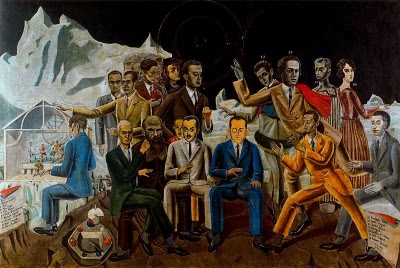
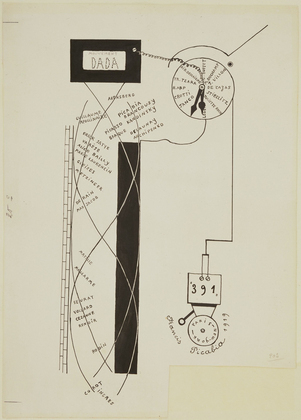 Francis Picabia - The Dada Movement
Francis Picabia - The Dada Movement